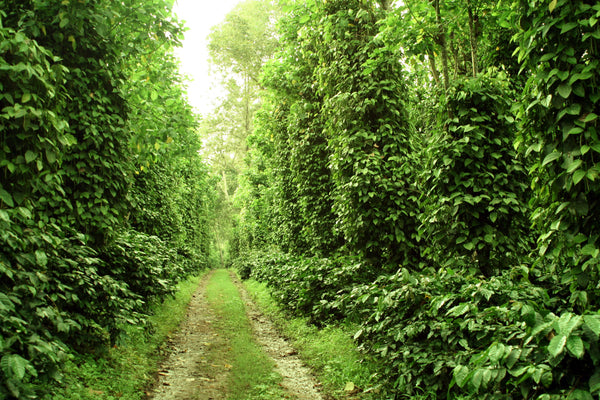When we ventured out to meet the farms that we wanted to work with, we were struck by the farms' natural lush beauty, their complex biodiversity as well as the incredible amount of work that goes into each step of processing every single coffee bean.

Bibi Plantation Farm
It was important for us to visually capture what we saw in a way that would engage more people to think about the growing and roasting process of coffee beans. If you take a look at the artwork behind our packs, you'll see that each piece of art highlights some of these aspects whether it's the biodiversity or daily nuances of life in a coffee farm or certain stages of processing of beans. We receive a number of requests to learn more about our artwork and this blog post serves to celebrate the talented artists we've had the opportunity to work with.
Since not everyone wants to hang a coffee pouch on their wall (though some people do!), we’ve also created prints of some of the pieces and 50% of the profits from these items will go back to the artist.

Jagdish Chitara is an Ahmedabad based Waghari Artist. His artwork follows a unique style called Mata Ni Pachedi. Usually, Mata Ni Pachedi artworks use cloth as a medium, but Jagdish, as with all the other artists that we worked with, was incredibly flexible and open to creating his art on any medium.
Mata Ni Pachedi, literally translates to “behind the Mother Goddess” or “following the Mother Goddess” and originated in Kheda district, in and around Ahmedabad, Gujarat. A 300-year-old art tradition, Mata Ni Pachedi is the creation of intricate cloth artwork that become wall hangings and backdrops for temples. The art form is often referred to as Kalamkaari (Kalam = pen/stylus and Kaari = skill/process). The artwork uses a combination of conventional block printing on cloth and then minute coloring in with kalams to bring out the fine details.

Mata ni Pachedi image; Source: Gaatha Blog
The main characteristic feature of Mata Ni Pachedi is that the center of the painting consists of a figure of the Mother Goddess while the right and left contain motifs including mythological characters, human figures, musicians, sacrificial animals and flowers. The borders of the painting are bold and ornate.
Traditionally, Mata Ni Pachedi was a ritual gesture of respect for the Mother Goddess and it is believed that a bountiful nature is her gift to her followers. “Peacock and Bull” and “The Elephant and The Boar” are two pieces of art that Jagdish created for our pouches. The nature-oriented theme behind these pieces highlights the bird friendly and shade grown aspects of Indian coffee farms and reflects Mata Ni Pachedi’s ancient beliefs of respecting and observing nature.

Left: 'The boar and the elephant'; Right: 'The bull and the peacock'; Source: Blue Tokai Coffee
Sukhnandi Vyam

Source: Mid-Day
Gond artist Sukhnandi Vyam created The Coffee Tree which was the first piece of art that we featured on our pouches. Sukhnandi’s art form, Gond art, visually reflects folk tales and traditional Gond culture originally communicated through song. Traditionally, the Pardhan Gonds would pass on their tribe’s folklore by singing and playing a stringed instrument called the ‘Bana’. Gond art is considered to be the visual translation of these tales. And it is the Pardhans who bear the onus of keeping these folk tales and songs alive with their renditions over the years. A curious mix of traditional with the individualistic impression of each Pradhan storyteller, the Gond Art has acquired a signature style that always has something new to offer.
Given the popularity of this art form, Gond art can now be found on screen prints, wooden artwork and canvasses throughout the country and, as was done traditionally, Gond artists still decorate the walls and floors of their mud huts with paintings in the belief that good art brings good luck.
Sukhnandi’s Coffee Tree reflects the balance that Gond art is known for. Through fine lines and dots, Sukhnandi created a symmetrical piece which reflects the Gond tribe’s core belief in the sanctity of nature. The tribes believe that nature is sacred and connected to all life. The fictitious Coffee Tree that Sukhnandi created for us accentuates the intermingling of human life with forest animals that surround coffee shrubs.

'The coffee tree' by Sukhnandi Vyam; Source: Blue Tokai Coffee
Teju ben and Govind Jogi

Ganesh Jogi and Teju Ben; Source: folkart.org
It was fate that led Teju ben and her son, Govind Jogi, to art. Teju ben recounts her life before she started drawing. Accompanied by a sarangi, Teju ben and her late husband, Ganesh, wandered through their village in Rajasthan singing traditional songs of praise at dawn just like Ganesh’s forefathers had done before him. In exchange, they were given food or money, but this tradition wasn’t financially sustainable. The poverty they faced was acute and they moved to Gujarat and did manual labour for very little money.
Through sheer luck, Ganesh Jogi happened to meet Haku Shah, a cultural anthropologist, painter, and author on tribal art and culture. This encounter would change Ganesh Jogi’s life.
Haku Shah encouraged Ganesh to express himself through pen and paper and although Ganesh barely knew how to hold a pen, he started to draw whatever was on his mind. Teju ben told us that she was also invited to draw by Haku Shah a few years later and that she initially found the task daunting but quickly became more comfortable expressing herself. Teju ben’s art reflects her sense of displacement which in some ways attributed to her unique perspective on the depiction of people, and city life in her work.

Artwork by Teju ben; Source: bookshop.mousover.in
In the same manner in which Haku Shah had encouraged them to draw, Teju ben and Ganesh bhai also allowed their children complete freedom in expressing themselves using pen and paper. Govind Jogi is their third child and his style is very different from Teju ben’s. When they both visited our roasterie, it was a non-roasting day and the main job being carried out was the sifting of beans. They both drew their own versions of this sight. Teju ben created an image of lots of women sifting beans with bags and bags of beans around them. In contrast, Govind drew an image of a single person sifting beans under a tree. They both make use of repetitive shapes and very fine details but in incredibly different settings and with equally unique styles.

Left: 'A woman sifting green beans' by Govind Jogi; Right: 'Women sifting beans' at our roasterie by Teju Ben
Source: Blue Tokai Coffee
In working with artists like Teju ben, Govind, Sukhnandi and Jagdish, we feel so lucky to be able to highlight the diversity of talent of India’s folk artists. The beauty with which they communicated their ideas about farm or roasterie life doesn’t just make us or our customers happy when they glance at our pouches, but they have, on a more deeper level, contributed in shaping the aesthetic vision for our work.
Want to get a hold of these beautiful artworks? It's simple. Just head to our collection of coffees and pick the coffee you like. Each Blue Tokai coffee pack comes adorned with one of these artworks. Or you can go to our poster collection and pick something to decorate your space.





